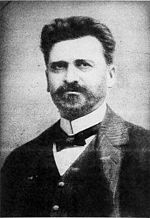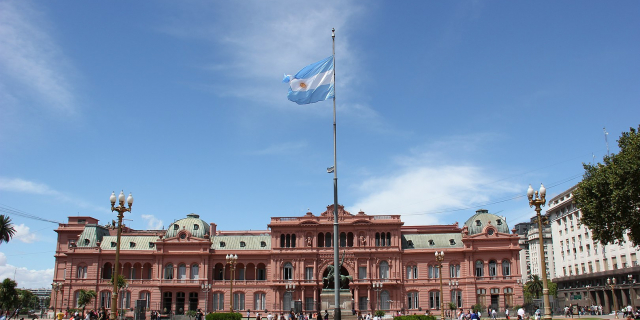Pigüé (Spanish pronunciation: [piˈɣwe]) is a town in Argentina located in the Pampas, 584 km (363 mi) south-west of Buenos Aires. It was founded by 165 Occitan-speaking French immigrants from Aveyron (Avairon in occitan) and one Argentine of direct Irish descent on December 4, 1884. The urban population is now 13,822 (INDEC 2001) and has increased by 9.5% since the 1991 census. Pigüé is the administrative centre of Saavedra Partido, Buenos Aires Province.
Pigüé, Pi-Hue, which means gathering place in Mapuche tongue, is home to an Occitan-speaking community coming from Rouergue, Occitania. It is located where two chains of hills meet, the Cura Malal to the west and the Bravard to the east. But Pigüé would never exist as a town were it not for Clément Cabanettes, a man born in 1851 in the small village of Ambec, commune of Lassouts near Saint-Côme (Sant Còsme d’Òlt en occitan) in the southern French département of Aveyron (Avairon). Cabanettes, then 33 of age, organized the voluntary exile of forty poverty-stricken farming families (as in "groups of relatives") from the surrounding communes of Espalion, Gabriac, Naucelle, Aurelle and Saint-Geniez-d'Olt (Sent Ginièis d'Òlt), to name but a few, to South America.
Having left Rodez (Rodés in occitan), the préfecture of Aveyron, by train on October 23, 1884 and reached the city of Buenos Aires, Argentina on a combined steam- and sailing-ship called Belgrano from Bordeaux (October 25) some 38 days later, they arrived at the brand-new railway station of what would become Pigüé on December 3, 1884. The "Aveyron colony", reminiscent of the Mayflower, subsequently welcomed more immigrants from the Rodez area and eventually became, after a very unlucky and ruinous start, one of the most prosperous settlements in the Pampas. Around 20,000 people now live in and around Pigüé, in the Buenos Aires district of Saavedra.
Background and preparation Clément Cabanettes
Clément CabanettesSecond Lieutenant Cabanettes had initially travelled to Buenos Aires in 1879 where he'd been hired to drill Argentine troops. In the following year he started the first telephone company in the country, "El Pan Teléfono" (sometimes also "La Pantelefónica"), before resigning for mutual incompatibility with the board. He then moved to Olavarría and worked in the wheat-harvesting machinery business. That is when he thought of bringing fellow countrypeople from Aveyron to the Pigüé area where he'd just bought 270 square kilometres of land, which the Government of the Buenos Aires Province had sold him for a derisory sum in recognition of his services. Cabanettes instantly fell in love with the place: it reminded him of his native Aubrac. With the financial help and persuasive know-how of his friend Eduardo Casey, Cabanettes managed to have the Pigüé station added to the planned railway line of Ferro Carril Sud. They also had accommodation and a huge silo built for the future settlers, plus a well dug.
Cabanettes returned to Aveyron where his friend François Issaly had already started promoting the Pigüé colony, offering each settler two square kilometres of land to cultivate for the next six years on condition that they gave half of their harvest to the community. At the end of this trial period, the settler would receive a title deed, whatever the value of the crops they'd shared over the six years. All the settlers were asked was a 5,000-franc contribution for the purchase of cattle, seeds and machines, but it turned out that many actually never paid the full price, which left Cabanettes even more indebted to Casey, whom he had borrowed money from. Given that unemployment was rife in and around Rodez following massive job cuts in the Decazeville mining industries, overpopulated rural areas and the phylloxera crisis (1882-1890), Cabanettes's idea aroused some interest. Meanwhile, the Aveyron press grew hostile to Cabanettes's project, accusing "the adventurer" of exploiting poor people's misery and painting in glowing colours a most dangerous place full of ferocious and vicious exotic beasts.
First steps in the promised land Eduardo Casey
Eduardo CaseyDespite these initial difficulties, the 163 colonists, who also comprised a teacher, a blacksmith, a cartwright, a priest and a tradesman, were found and brought to Pigüé where they enthusiastically started cultivating the land, although the first harvest of wheat was quite disappointing. The farming techniques were obviously the ones used back home in Aveyron but these were not the best option with much different climate, relief and soil. The second year was even worse, with drought from the month of March through September. Some sowed maize and potatoes on top of the corn, fearing nothing would come out at all. However, heavy rains fell in autumn, which proved enough for all crops to grow, providing for a mediocre harvest. Still, the settlers kept the faith and none returned to France. On the contrary, more arrived. "The promised land" was well worth the sacrifices, according to letters they sent to their relatives. "Monsieur Cabanettes cannot be accused of promising more butter than bread".
On the third year though, finding himself unable to repay Casey as planned, Cabanettes asked and obtained a twelve-month extension of due date. But this was not enough for Pigüé to make profits and Casey first decided, as his contract allowed him to, to repossess all land but eventually changed his mind and chose to grant Cabanettes an extra 50,000 pesos instead, thus wiping his friend's slate clean. The whole colony, facing growing difficulties despite breeding more bovine cattle than sheep now, turned out to be a complete failure and the Government of Buenos Aires finally bought back the settlement at the price of naked land, ignoring the buildings and crops, and leaving Cabanettes with no benefits and glory. Cabanettes and Casey died even poorer than the families they saved and gave back hope to but their generosity and blind perseverance ensured that Pigüé remains to this day a grateful piece of Aveyron in South America.






![[محمد السيد] - CC BY 2.0](/sites/default/files/styles/640x320/public/pla/images/2020-05/1280px-M.FERNANDEZ.jpg?h=29234840&itok=HPVGkIVA)






















Add new comment